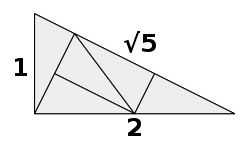Pinwheel tiling
In geometry, pinwheel tilings are non-periodic tilings defined by Charles Radin and based on a construction due to John Conway. They are the first known non-periodic tilings to each have the property that their tiles appear in infinitely many orientations.
Definition
[edit]
Let be the right triangle with side length , and . Conway noticed that can be divided in five isometric copies of its image by the dilation of factor .[1]


The pinwheel tiling is obtained by repeatedly inflating by a factor of and then subdividing each tile in this manner. Conversely, the tiles of the pinwheel tiling can be grouped into groups of five that form a larger pinwheel tiling. In this tiling, isometric copies of appear in infinitely many orientations because the small angle of , , is not a rational multiple of . Radin found a collection of five prototiles, each of which is a marking of , so that the matching rules on these tiles and their reflections enforce the pinwheel tiling.[1] All of the vertices have rational coordinates, and tile orientations are uniformly distributed around the circle.[2]
Generalizations
[edit]Radin and Conway proposed a three-dimensional analogue which was dubbed the quaquaversal tiling.[3] There are other variants and generalizations of the original idea.[4]

One gets a fractal by iteratively dividing in five isometric copies, following the Conway construction, and discarding the middle triangle (ad infinitum). This "pinwheel fractal" has Hausdorff dimension .
Use in architecture
[edit]
Federation Square, a building complex in Melbourne, Australia, features the pinwheel tiling. In the project, the tiling pattern is used to create the structural sub-framing for the facades, allowing for the facades to be fabricated off-site, in a factory and later erected to form the facades. The pinwheel tiling system was based on the single triangular element, composed of zinc, perforated zinc, sandstone or glass (known as a tile), which was joined to 4 other similar tiles on an aluminum frame, to form a "panel". Five panels were affixed to a galvanized steel frame, forming a "mega-panel", which were then hoisted onto support frames for the facade. The rotational positioning of the tiles gives the facades a more random, uncertain compositional quality, even though the process of its construction is based on pre-fabrication and repetition. The same pinwheel tiling system is used in the development of the structural frame and glazing for the "Atrium" at Federation Square, although in this instance, the pin-wheel grid has been made "3-dimensional" to form a portal frame structure.
References
[edit]- ^ a b Radin, C. (May 1994). "The Pinwheel Tilings of the Plane". Annals of Mathematics. 139 (3): 661–702. CiteSeerX 10.1.1.44.9723. doi:10.2307/2118575. JSTOR 2118575.
- ^ Charles Radin (1997). The mathematics of long-range aperiodic order. Dordrecht ; Boston: Kluwer Academic Publishers. pp. 499–519. ISBN 0-7923-4506-1.
- ^ Conway, John H.; Radin, Charles (1998), "Quaquaversal tilings and rotations", Inventiones Mathematicae, 132 (1): 179–188, Bibcode:1998InMat.132..179C, doi:10.1007/s002220050221, MR 1618635, S2CID 14194250.
- ^ Sadun, L. (January 1998). "Some Generalizations of the Pinwheel Tiling". Discrete and Computational Geometry. 20 (1): 79–110. arXiv:math/9712263. CiteSeerX 10.1.1.241.1917. doi:10.1007/pl00009379. S2CID 6890001.
External links
[edit]- Pinwheel at the Tilings Encyclopedia
- Dynamic Pinwheel made in GeoGebra










